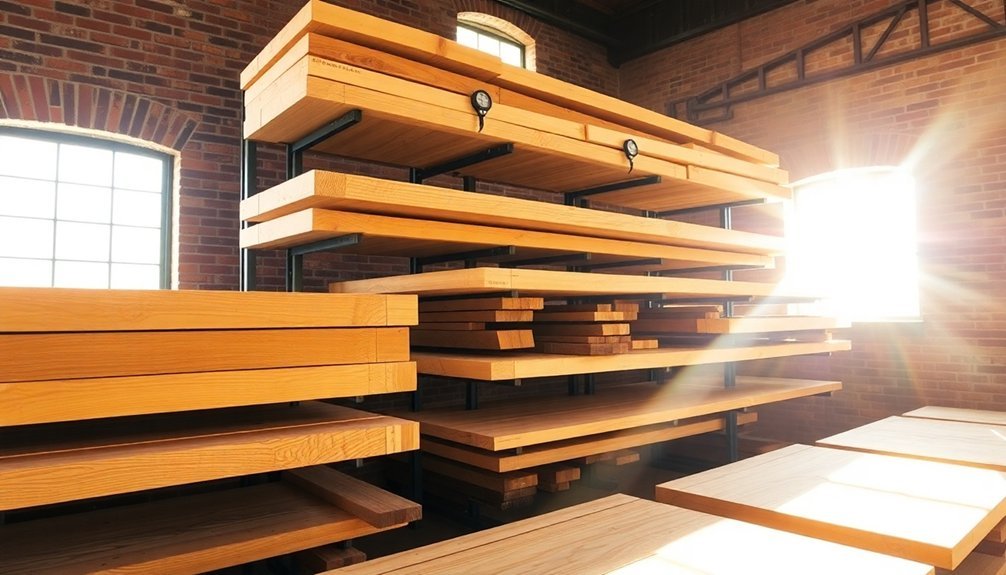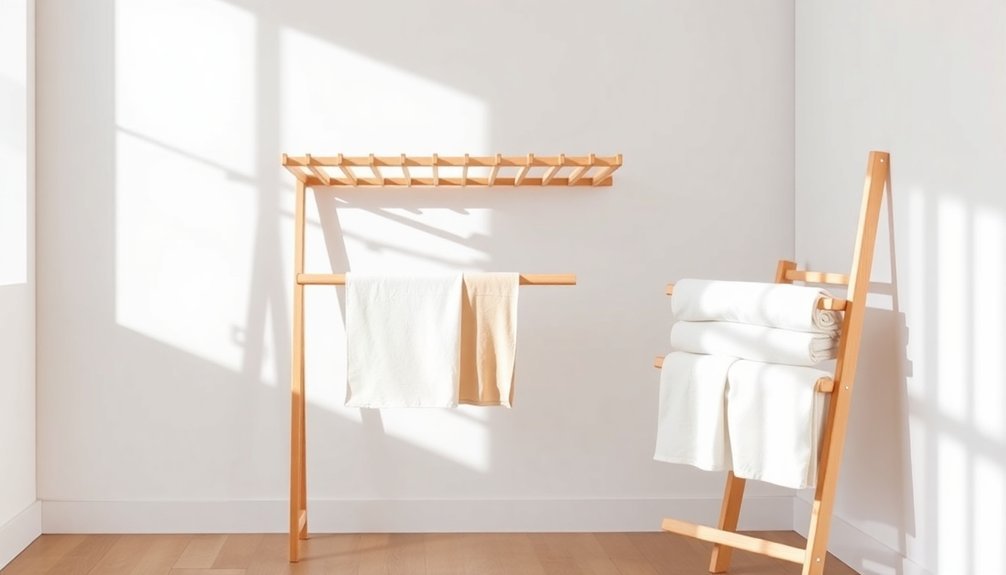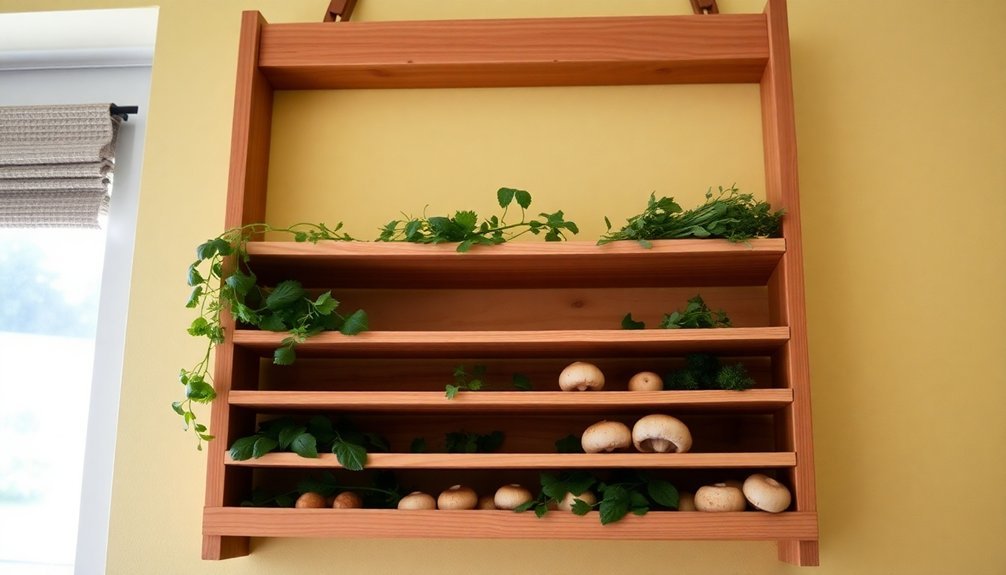Timber drying racks offer you a smart, eco-conscious choice for your home. You'll benefit from significant cost savings, potentially reducing your electric bills by up to $267 annually while supporting sustainable practices. These durable North American hardwood racks won't snag your clothes and require minimal maintenance, lasting far longer than plastic alternatives. They're naturally antibacterial and provide excellent airflow, preventing mold and ensuring your items dry properly. Beyond the practical benefits, you're also helping combat climate change since wood stores carbon dioxide. There's even more to discover about these sustainable household solutions.
Natural Benefits of Wood Construction

When it comes to wood construction, nature's own building material offers remarkable environmental benefits that go far beyond its aesthetic appeal.
You'll be contributing to carbon sequestration when you choose timber, as wood naturally stores carbon dioxide within its fibers, even after it's been harvested and crafted into your drying rack. This means you're actively helping to combat climate change through your purchase.
You're also making an energy-efficient choice, as wood's natural insulating properties help maintain consistent temperatures. Choosing timber supports sustainable forest management through responsible harvesting and replanting practices.
This characteristic means you won't need to worry about temperature fluctuations affecting your drying items. Additionally, you'll appreciate that timber production requires considerably less energy compared to materials like steel or concrete, making it an environmentally responsible choice from manufacturing to installation.
Cost Savings and Durability
Your investment in a quality timber drying rack will quickly pay for itself through significant energy savings of up to $267 annually on your electric bills.
The smooth wooden dowels prevent snagging clothes and ensure your linens come out looking crisp and fresh.
You'll appreciate the robust hardwood construction, featuring thick dowels and screwed joints that guarantee the rack remains stable and functional for years to come.
The minimal maintenance requirements and lifetime durability make this rack a practical choice compared to cheaper alternatives that need frequent replacement.
Long-Term Financial Benefits
The long-term financial benefits of a timber drying rack extend far beyond its initial purchase price. You'll see immediate savings on your energy bills, with $0.40 to $1.10 reduced costs per load of laundry. For a typical family doing 365 loads annually, this translates to potential savings between $73 and $267 per year, depending on whether you reduce dryer usage by one-third or one-half.
The payback period for your investment is remarkably short, ranging from six months to two years. Unlike plastic or epoxy alternatives that might need replacement every couple of years, your wooden rack's durability guarantees it'll serve you much longer. The space-saving design makes it an excellent investment for apartments and small homes.
You won't face the ongoing costs of repairs or replacements that often come with cheaper materials, as timber racks don't rust, corrode, or deteriorate quickly.
When you consider the minimal maintenance requirements and the rack's ability to withstand regular use, you're making a smart financial decision. Your investment continues to generate returns through reduced energy bills, fewer replacement costs, and extended product life.
With potential annual savings of up to $200, you'll find that choosing a timber drying rack is a financially sound decision for your household.
Robust Construction Investment
Investing in robust construction pays dividends far beyond initial savings. When you choose a timber drying rack made from North American hardwood, you'll get a structure that's built to last and perform effectively for years. The solid wood construction, using ¾" x 1 ¼" unfinished hardwood frames and screw-attached dowels, provides superior durability compared to plastic or epoxy alternatives.
Your investment in proper construction techniques guarantees peak performance. The foundation, set at least 12" off the ground, creates essential airflow, while deck blocks and string lines ensure a perfectly level base.
With floor joists spaced 16" apart and a width that doesn't exceed 6', you'll maintain ideal air circulation while supporting heavy wet items like jeans and comforters.
This thoughtful construction approach translates into significant long-term savings. You'll cut your energy bills by $50 to $200 annually while reducing your carbon footprint.
The rack's durability means you won't need frequent replacements, and its careful design, with thicker wood at the bottom and stickers placed over support beams, ensures it'll handle heavy loads consistently over time.
Minimal Maintenance Required
Maintaining a timber drying rack couldn't be simpler, making it a practical choice for cost-conscious homeowners. You'll appreciate how these durable wooden structures require minimal attention while delivering consistent performance year after year.
Unlike plastic alternatives that can crack or break, timber racks remain stable and functional with basic care. The natural properties of high-quality North American hardwood, combined with superior construction methods using screws instead of staples, guarantee your rack stays robust even with heavy, wet items.
You won't need to worry about complex mechanisms failing or parts wearing out, as the straightforward design eliminates potential maintenance headaches.
- No special cleaning products or chemicals required – just occasional dusting and wiping
- Foldable design allows for easy storage without risking damage to components
- Sturdy construction eliminates the need for frequent repairs or part replacements
When you're not using your timber drying rack, it folds away neatly, protecting it from unnecessary wear. This practical feature, coupled with the rack's inherent durability, means you'll spend less time on maintenance and more time enjoying the benefits of natural clothes drying.
Your investment will continue to serve you well with minimal effort on your part.
Space Management and Storage

Proper space management starts with carefully planning your timber drying rack's location and layout. You'll need to select an open area that maximizes natural air flow while keeping your timber protected from harsh weather conditions.
The rack's base shouldn't exceed 6 feet in width, but its length can accommodate your longest boards, ensuring ideal air circulation around your wood stack.
When you're arranging your timber, you'll want to organize it strategically. Place your thickest and longest boards at the bottom of the stack, gradually working up to thinner pieces. By positioning stickers directly above the 2×4 supports and maintaining consistent 4-foot spacing, you'll create uniform air channels throughout the stack.
This systematic approach lets you store more timber while maintaining proper ventilation.
Remember to keep your stack's edges aligned with the platform and maintain at least 12 inches of ground clearance. You'll also need to factor in additional space around the rack for easy access and air movement.
If you're using multiple racks, space them apart to prevent creating wind blocks that could impede the drying process.
Environmental Impact
When you're selecting a timber drying rack, you'll considerably reduce your carbon footprint by choosing designs that maximize natural airflow and minimize energy consumption.
Your rack's orientation can harness natural wind patterns and sunlight, cutting down on artificial drying methods that contribute to greenhouse gas emissions.
You'll find that properly spaced racks working with nature's elements not only dry lumber effectively but also represent a more sustainable approach to timber processing.
Reduced Carbon Footprint
Timber drying racks consistently offer considerable environmental advantages through their reduced carbon footprint. When you choose a timber drying rack, you're participating in a process that uses markedly less embodied energy compared to other construction material handling methods.
The energy required to process and transport timber is minimal, which translates directly to fewer greenhouse gas emissions throughout the production cycle.
Your choice of timber drying racks supports a natural carbon storage system. Trees absorb CO2 during their growth, and this carbon remains locked in the wood throughout its service life.
When you dry timber properly on racks, you're preserving approximately 50% of the wood's dry weight as stored carbon, making it an effective long-term carbon storage solution.
- Drying racks enable ideal airflow, reducing the need for energy-intensive kiln drying processes
- They support the natural properties of wood as a renewable resource with lower global warming potential
- Your timber storage solution maintains wood quality while contributing to reduced CO2 emissions compared to steel or concrete alternatives
The efficiency of rack drying complements sustainable forestry practices, helping maintain forests as active carbon sinks while meeting your construction material needs.
Natural Energy Solutions
Natural energy solutions represent a critical aspect of modern timber drying systems, especially as you consider their environmental impact. By choosing a timber drying rack that incorporates sustainable practices, you'll maximize energy efficiency while minimizing your ecological footprint. You can harness natural heat through proper rack positioning and utilize recycled heat from existing processes to reduce energy consumption.
Modern drying racks let you optimize your loads while monitoring moisture content precisely, ensuring you're not wasting energy through over-drying. You'll find that these systems align perfectly with sustainable practices and industry standards, helping you meet growing consumer demand for eco-friendly wood products.
| Energy Source | Benefits | Implementation |
|---|---|---|
| Solar Heat | Zero emissions | Strategic rack placement |
| Wind Flow | Natural ventilation | Open-air design features |
| Ambient Temperature | Reduced energy costs | Seasonal timing optimization |
When you integrate these natural energy solutions into your timber drying process, you'll notice significant improvements in both efficiency and environmental performance. The combination of optimized loading patterns, recycled heat utilization, and precise moisture monitoring creates a sustainable drying system that reduces your operation's carbon footprint while maintaining high-quality wood products.
Food Safety and Quality Preservation

Proper food safety and quality preservation are paramount considerations when selecting a timber drying rack. You'll find that wooden drying racks offer natural antibacterial properties, making them superior to plastic alternatives that often require harsh detergents.
When you properly dry your wooden kitchenware, you're preventing bacterial growth and maintaining the dimensional stability that's essential for food safety. Your wooden items will benefit from proper airflow, which prevents moisture accumulation and reduces mold risks.
By using a timber drying rack, you're ensuring that your wooden utensils and cutting boards maintain their food-safe properties without exposing your food to toxic chemicals or unwanted flavors. The natural characteristics of wood help preserve food quality while preventing the transfer of chemical tastes that can occur with synthetic materials.
- Natural antibacterial properties eliminate the need for strong chemical cleaners
- Proper airflow prevents moisture buildup and bacterial growth
- Wood's porous nature maintains food flavors without chemical contamination
The right drying rack helps you maintain the correct moisture content in your wooden items, typically around 7% for indoor use, ensuring they remain stable and safe for food preparation.
Assembly and Maintenance Requirements
Your drying rack's assembly process requires careful attention to detail and basic woodworking skills. You'll need 1×2 pine for the frame, netted laundry bags, pocket hole screws, and 5/16″ wood dowels. Start by measuring and cutting the wood to your desired dimensions, then dry-fit the frame before drilling holes for dowels and pocket screws.
| Task | Frequency | Tools Needed |
|---|---|---|
| Clean Rack | Weekly | Damp cloth, mild soap |
| Inspect Joints | Monthly | Screwdriver |
| Wood Treatment | Quarterly | Wood conditioner |
| Rung Maintenance | Bi-annually | Fine sandpaper |
To maintain your rack's longevity, you'll need to implement regular cleaning and maintenance routines. Wipe it down with a damp cloth and mild soap when needed, but avoid using bleach on wooden components. Inspect for loose screws or signs of wear periodically, and sand the rungs lightly to prevent snags. When storing your rack, keep it in a cool, dry place and fold it properly to avoid stressing the joints. You'll want to pay attention to weight distribution when using the rack – overloading can lead to premature wear and potential damage.
Frequently Asked Questions
Can Timber Drying Racks Be Used in High-Humidity Climates?
Yes, you can use timber drying racks in high-humidity climates. They're designed with dehumidification systems that control moisture levels, and you'll just need to monitor them more frequently to maintain ideal drying conditions.
How Long Does It Take for Clothes to Dry on a Wooden Rack?
Your clothes' drying time on a wooden rack typically varies from 4-24 hours, depending on your environment's temperature, humidity, and air circulation. You'll see faster results in warm, dry, well-ventilated spaces.
Are Timber Drying Racks Safe to Use Around Pets and Children?
Yes, timber drying racks are safe when you follow proper precautions. You'll need to supervise children, keep pets from chewing the wood, and guarantee the rack's stable placement. Regular safety checks are essential.
What Types of Wood Are Best for Outdoor Drying Racks?
For outdoor drying racks, you'll want to choose naturally weather-resistant hardwoods like maple or birch. They're durable and resist moisture well. Just remember to store them inside when they're not in use.
Can Timber Racks Develop Mold if Used Continuously Indoors?
Yes, your timber rack can develop mold indoors if it's constantly wet. You'll need to guarantee proper drying between loads and maintain good ventilation. Regular cleaning with vinegar will help prevent mold growth.
In Summary
You'll find that a timber drying rack is a wise investment that'll serve you well for years to come. With its natural antibacterial properties, cost-effective construction, and smart space utilization, it's an eco-friendly choice that helps preserve your food's quality. While you'll need to maintain it properly, the minimal upkeep is worth the durability and sustainability you're getting. It's time to make the switch to timber.





Leave a Reply